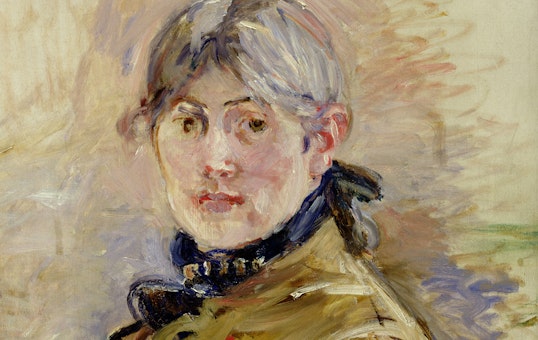
Berthe Morisot. Self-Portrait, 1885. © Musée Marmottan Monet, Paris, Denis and Annie Rouart Foundation. © Bridgeman
About the Exhibition
Berthe Morisot (French, 1841–1895), one of the major impressionists, worked alongside Edgar Degas, Édouard Manet, Claude Monet, and Pierre-Auguste Renoir. This exhibition traces the exceptional path of a woman who defied the social norms of her time to join the Parisian avant-garde.
Through her portrayal of the human figure, Morisot explored impressionist themes of modernity: the intimacy of contemporary bourgeois living and family life, the taste for resorts and gardens, the importance of fashion, and women’s domestic work. Deliberately sketchlike and unfinished in appearance, her works are not an unmediated reflection of her daily environment: they address the temporality of representation itself in a careful capture of the world that attempts to “fix something of the passing moment.”
Her Path and Process
This exhibition charts the course of Morisot's career in rough chronological order, taking cues from major themes in her work and life.
“Work is the sole purpose of my existence. . . . Indefinitely prolonged idleness would be fatal to me from every point of view.”
—Berthe Morisot, 1871
Becoming an Artist
From her early artistic training, Berthe Morisot showed a strong independence of mind. Instead of practicing art as a hobby, as upper-middle-class young women usually did, Morisot and her sister Edma hoped to be professional artists. They studied with the respected landscape painter Camille Corot and made their public debut at the Paris Salon of 1864. Unlike Edma, who gave up her professional ambitions after marriage, Morisot continued to pursue hers.
She met the painter Édouard Manet in 1868 and began to forge ties with the Parisian avant-garde. In 1874, she joined a radical new artists' cooperative, becoming the only female artist to show in their first exhibition. Critics derisively dubbed the group the “impressionists” for their unpolished, seemingly unfinished work, but Morisot was undeterred. Some of the paintings she exhibited that year count among her most iconic.
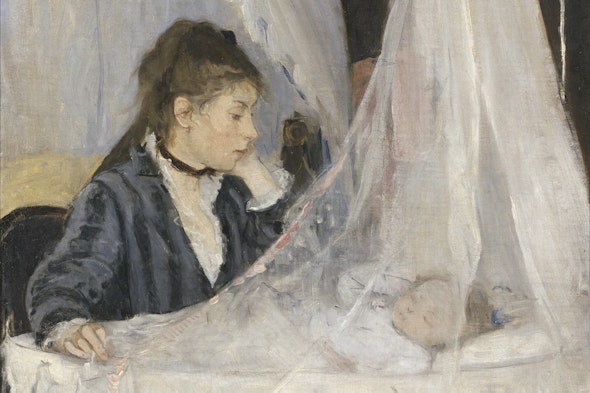
Berthe Morisot. The Cradle (detail), 1872. Musée d’Orsay, Paris. © Musée d’Orsay, Dist. RMN-Grand Palais / Patrice Schmidt
Painting Outdoors
In the 19th century, painters tended to make only studies and sketches outdoors, or en plein air, not finished pictures. Morisot and the impressionists defied this convention and exhibited works painted largely outdoors to convey the fleeting effects of light and weather.
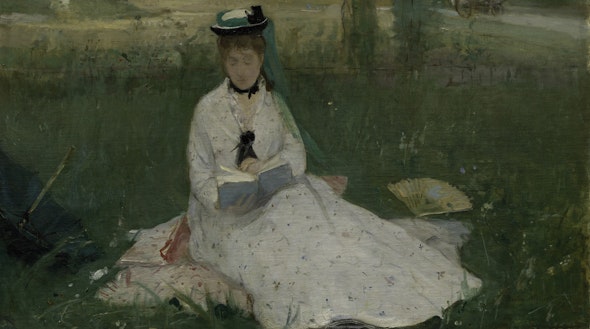
Berthe Morisot. Reading (detail), 1873. The Cleveland Museum of Art. Gift of the Hanna Fund
Fashion and the Modern Woman
A stylish woman herself, Morisot became the quintessential painter of contemporary women, especially the figure known as the Parisienne. A chic, urban sophisticate, the Parisienne came to symbolize modern life in the French capital.

Berthe Morisot. Winter, 1880. Dallas Museum of Art, Gift of the Meadows Foundation, 1981. Photo courtesy Dallas Museum of Art
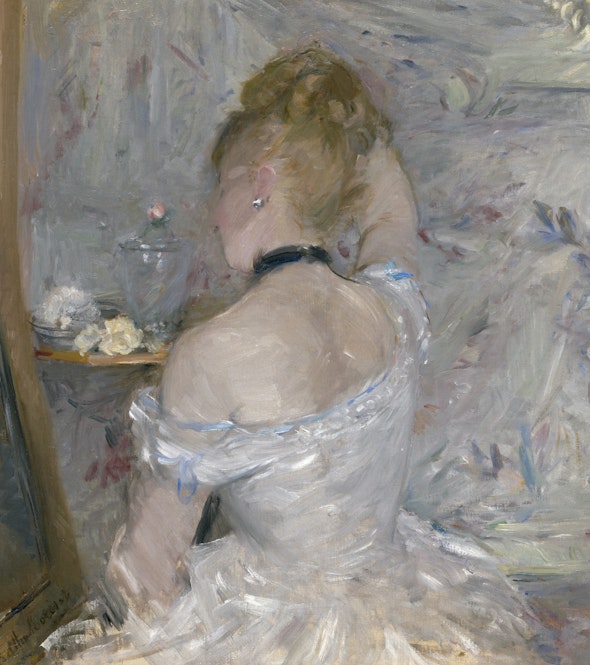
Berthe Morisot. Woman at Her Toilette, 1875–1880. The Art Institute of Chicago. Photo courtesy The Art Institute of Chicago / Art Resource, NY
Finished / Unfinished
During the 1880s, Morisot’s brushwork became increasingly free, with loose, rapid strokes accentuating the flat surface of the canvas. In works with a deliberately unfinished appearance, she used impressionist landscape techniques to depict portraits and figures.
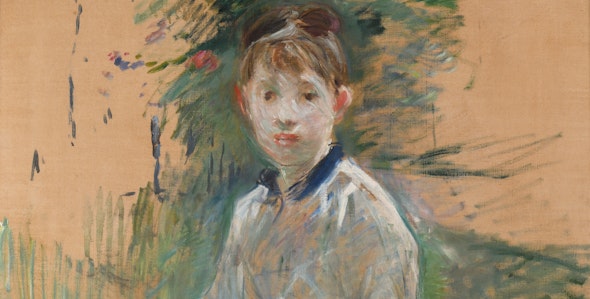
Berthe Morisot. Portrait of Miss L.[ambert] (detail), 1885. Private collection
Women at Work
Working women are a recurring subject in Morisot’s painting. The cooks, maids, and servants employed by upper-middle-class households in the late 19th century were as much a part of Morisot’s daily life as her family and friends.
In an 1885 self-portrait, Morisot depicted herself as a working artist, a status that depended on the women who helped run her household.

Berthe Morisot. Self-Portrait, 1885. © Musée Marmottan Monet, Paris, Denis and Annie Rouart Foundation. © Bridgeman
Threshold Spaces
Morisot was fascinated by in-between spaces—verandas, balconies, and other transitional areas of domestic interiors. The window in particular, as a long-established symbol in western art, enabled her to blend two distinct genres: interior scenes and outdoor painting. These fusions of inside and outside allowed Morisot to explore the subtle relationships between private and public spaces.
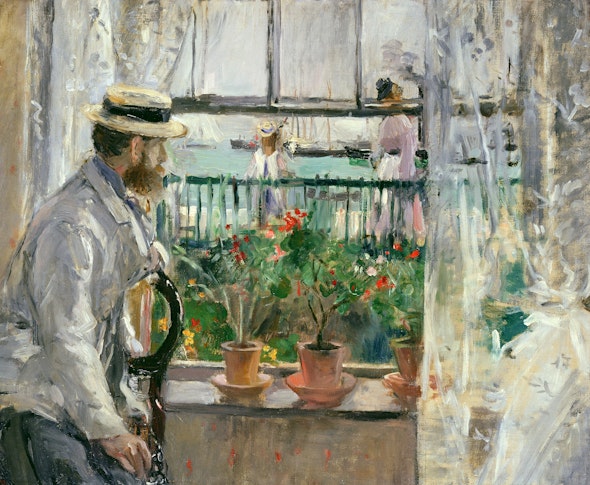
Berthe Morisot. In England, 1875. Musée Marmottan Monet, Denis and Annie Rouart Foundation. Photo by Erich Lessing / Art Resource, NY

Berthe Morisot. Cottage Interior, 1886. Musée d’Ixelles, Gift of Fritz Toussaint. Photo courtesy Collection Musée d’Ixelles
A Studio of One's Own
For most of her career, Morisot did not have her own studio. When she wasn't working outdoors, she generally painted in her bedroom or drawing room. She would clear away her easels and brushes to make space for the rituals of daily life.
After her husband, Eugène Manet, died in 1892, Morisot moved to an apartment, where she converted the servant quarters into a studio. However, she continued to work in the domestic spaces of her home, depicting her daughter and nieces playing music, painting, or drawing in the apartment.
Characterized by a new expressiveness, Morisot’s late work reveals an awareness of the emerging symbolist movement.
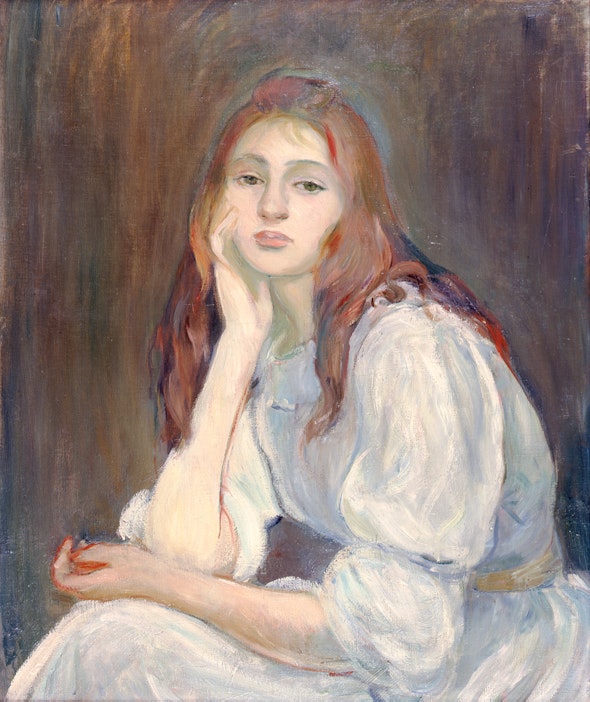
Berthe Morisot. Portrait of Miss J.[ulie] M.[anet] (Julie Dreaming), 1894. Private collection. Photo Galerie Hopkins, Paris
“I am approaching the end of my life, and yet I am still a mere beginner.”
—Berthe Morisot, 1890
Exhibition Organization
Berthe Morisot: Woman Impressionist is organized by the Barnes Foundation, the Musée national des beaux-arts du Québec, the Dallas Museum of Art, and the Musées d’Orsay et de l’Orangerie.
This exhibition will be the first dedicated presentation of Morisot’s work to be held in the US since 1987, the very first solo exhibition of her work to be mounted in Canada, and the first time since 1941 that a French national museum will devote a monographic show to this important painter.
The exhibition is co-curated by Sylvie Patry, deputy director for curatorial affairs and collections at the Musée d'Orsay and consulting curator at the Barnes Foundation, and Nicole R. Myers, the Lillian and James H. Clark Curator of European Painting and Sculpture at the Dallas Museum of Art.
The Barnes's presentation of Berthe Morisot: Woman Impressionist was managed by Cindy Kang, associate curator at the Barnes Foundation.
Sponsors
Denise Littlefield Sobel
Aileen and Brian Roberts
Maribeth and Steven Lerner
Bruce and Robbi Toll
Support for the exhibition comes from contributors to the Barnes Foundation Exhibition Fund:
Joan Carter and John Aglialoro, Julia and David Fleischner, Leigh and John Middleton, Jeanette and Joe Neubauer, Aileen and Brian Roberts
John Alchin and Hal Marryatt, Jill and Sheldon Bonovitz, Lois and Julian Brodsky, N. Judith Broudy, Laura and Bill Buck, Joan Carter and John Aglialoro, Dan and Monica DiLella, Gloria and John Drosdick, Eugene and Michelle Dubay, Lisa D. Kabnick and John H. McFadden, Marguerite and Gerry Lenfest, Victoria McNeil Le Vine, Leslie Miller and Richard Worley Foundation, Kay and Michael Park, Adele Schaeffer, Katie and Tony Schaeffer, Joan F. Thalheimer, van Beuren Charitable Foundation, Kirsten White, A. Morris Williams, Jr., Michele Plante and Robert N. Wilson, Anonymous
With generous support from the Philanthropy Circle Donors:
Laura and Bill Buck, Gretchen H. Burke, Dietz Family Foundation, FS Foundation, Joan L. Garde, Anne and Matt Hamilton, Penelope P. Harris, Lynne and Harold Honickman, Patricia H. Imbesi, Jane and Leonard Korman, Susan Martinelli Shea, Hilarie and Mitchell Morgan, Marsha and Jeffrey Perelman, Anne and Bruce Robinson, Richard and Marsha Rothman, Adele K. Schaeffer, Hank and June Smith
Additional funding from the Horace W. Goldsmith Foundation, the Jill and Sheldon Bonovitz Exhibition Fund, and The Rittenhouse Hotel.
The catalogue is made possible with generous support provided by the Lois and Julian Brodsky Publications Fund.
This exhibition is supported by an indemnity from the Federal Council on the Arts and the Humanities.




